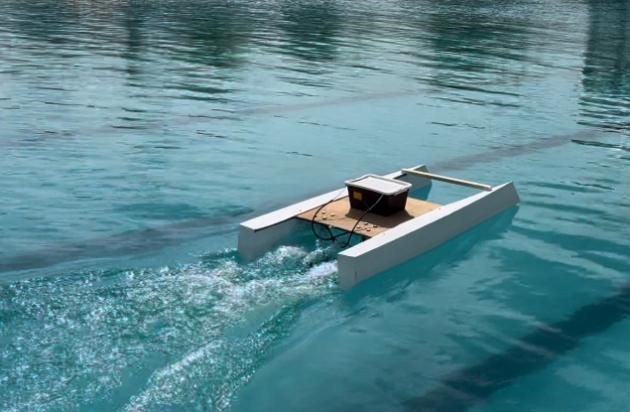EVALUATION OF AUTONOMOUS NAVIGATION AND PATH ACCURACY FOR UNMANNED SURFACE VEHICLES USING IMU SENSOR AND GPS DATA
DOI:
https://doi.org/10.11113/jtse.v11.236Keywords:
Robotic marine vessel, water quality monitoring, autonomous navigation, environmental monitoring, Aqua Sense, unmanned surface vehicleAbstract
The development of autonomous systems for environmental monitoring is becoming increasingly important. This project focuses on creating a robotic marine vessel, Aqua Sense, for efficient water quality monitoring. Existing methods are often labour-intensive, time-consuming, and lack real-time data capability. The objective is to develop a robotic vessel with autonomous navigation for water quality applications. A comprehensive design approach, including a literature review and careful component selection, was employed. Key components include the Arduino Mega, Blue Robotics T200 thruster, GlobalSat BU-353N5 GPS sensor, BNO055 Inertial Measurement Unit (IMU), and a Li-po 11.1v battery. In this paper, several field trials data collection is presented to evaluate the navigation algorithm. These findings validate the feasibility of Aqua Sense for real-world applications. The varying distance errors at points B and C demonstrate an error range, with a maximum error of approximately 1.130m at point B (about 0.11% of the target location) and a significant variation at point C, reaching up to 1.660m (approximately 0.15%).
References
P. Johnston and M. Poole, “Marine surveillance capabilities of the autonaut wave-propelled unmanned surface vessel (usv),” in OCEANS 2017-Aberdeen, pp. 1–46, IEEE, 2017.
A. Matos, E. Silva, N. Cruz, J. C. Alves, D. Almeida, M. Pinto, A. Martins, J. Almeida, and D. Machado, “Development of an unmanned capsule for large-scale maritime search and rescue,” in 2013 OCEANS-San Diego, pp. 1–8, IEEE, 2013.
J. L. Villa, J. Paez, C. Quintero, E. Yime, and J. Cabrera, “Design and control of an unmanned surface vehicle for environmental monitoring applications,” in 2016 IEEE Colombian Conference on Robotics and Automation (CCRA), pp. 1–5, 2016.
V. Jorge, R. Granada, R. Maidana, D. Jurak, G. Heck, A. Negreiros,D. Santos, L. Gonc,alves, and A. Amory, “A survey on unmanned surface vehicles for disaster robotics: Main challenges and directions,” Sensors, vol. 19, p. 702, 02 2019.
W. Al Maawali, A. Al Naabi, M. Al Yaruubi, A. Saleem, and A. Al Maashri, “Design and implementation of an unmanned surface vehicle for oil spill handling,” in 2019 1st International Conference on Unmanned Vehicle Systems-Oman (UVS), pp. 1–6, IEEE, 2019.
A. Papanikolaou, Ship design: methodologies of preliminary design. Springer, 2014.
M. Caccia, “Autonomous surface craft: prototypes and basic research issues,” in 2006 14th Mediterranean Conference on Control and Automation, pp. 1–6, IEEE, 2006.
Z. Liu, Y. Zhang, X. Yu, and C. Yuan, “Unmanned surface vehicles: An overview of developments and challenges,” Annual Reviews in Control, vol. 41, pp. 71–93, 2016.
Home. Seqwater. (2024, February 20). https://www.seqwater.com.au/

Downloads
Published
How to Cite
Issue
Section
License
Copyright of articles that appear in Journal of Transpot System Engineering (JTSE) belongs exclusively to Penerbit Universiti Teknologi Malaysia (Penerbit UTM Press). This copyright covers the rights to reproduce the article, including reprints, electronic reproductions or any other reproductions of similar nature.
Disclaimer: The views and opinions expressed in the articles are those of the authors and do not necessarily reflect the official policy or position of the JTSE. Examples of analysis performed within are only examples and they should not be utilized in real-world. Assumptions made within the analysis are not reflective of the position of any JTSE entities.

















